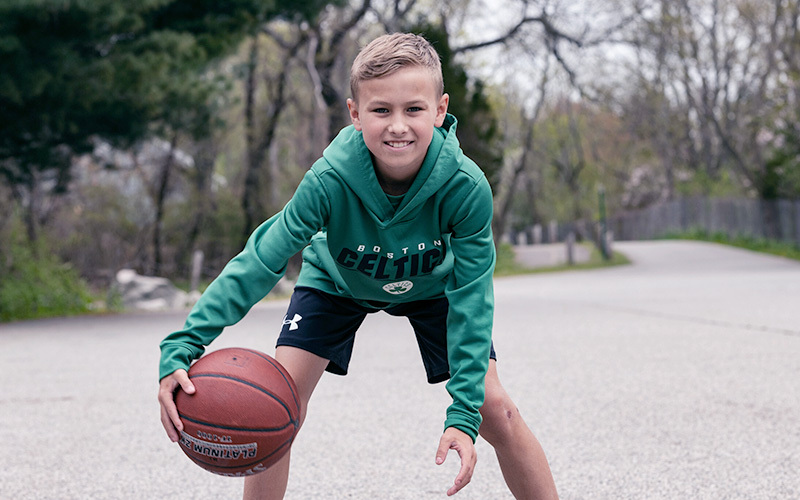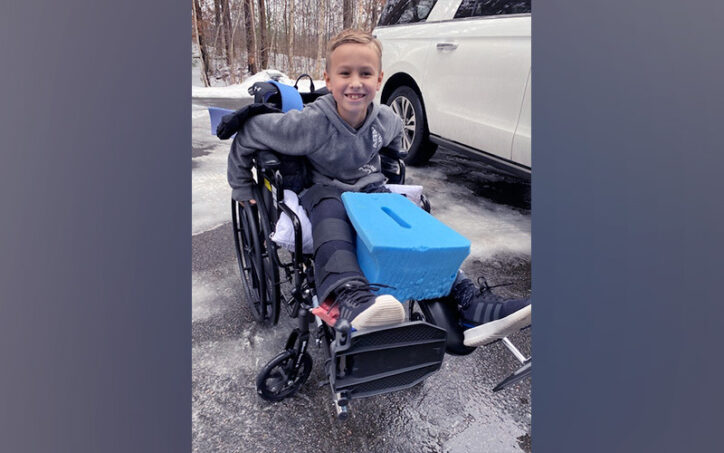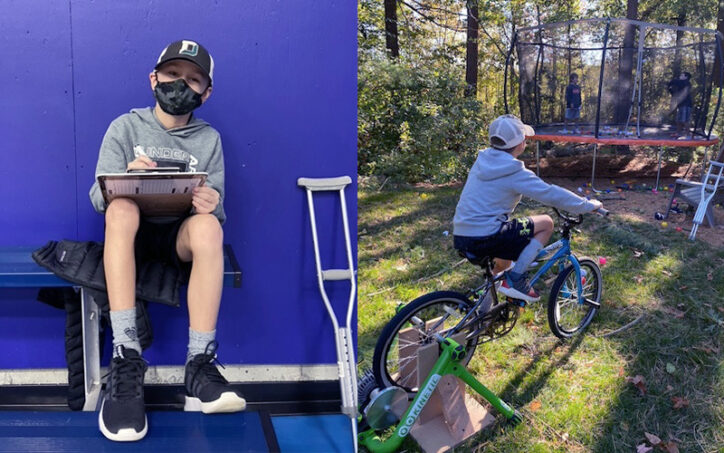Always an athlete: Drew and Legg-Calve-Perthes disease

When he looks back on the diagnosis that forced him to stop playing sports entirely for more than a year, 11-year-old Drew Coperine is philosophical. “There is a bright side,” he says, “there is an end to it.” But when he first learned that he had Legg-Calve-Perthes disease, a degenerative hip condition, it was hard not to feel like his world was crashing down.
Legg-Calve-Perthes disease (also known as Perthes disease) is a rare condition in which the ball-shaped head of the thighbone (femoral head) temporarily loses its blood supply. Starved of blood, and the oxygen it carries, the bone dies and starts to break down.
Mysterious symptoms, surprising diagnosis
Drew’s symptoms first appeared in early 2020, when he was 9 years old. “He had knee pain and started limping,” says his mom, Danielle. X-rays of the knee showed no signs of damage and Drew was told to take time off from sports to let his knee rest. Within days, the COVID-19 pandemic put an end to the spring season for everyone, making it easier for Drew to focus on healing.
By fall season, Drew felt ready to return to his previous level of activity. He played soccer, flag-football, and fall baseball. However, the pain quickly returned — this time it was in his hip — and his limp grew worse. His parents made an appointment at Boston Children’s Hospital.
Soon after Dr. Benjamin Shore of the Child and Young Adult Hip Preservation Program reviewed an x-ray of Drew’s hip, he sat down with the Coperines to break the news that Drew had Perthes disease. To prevent further damage, he needed to stop putting any weight on his leg at all.
“We went in expecting that Drew would need physical therapy. Instead, he walked out on crutches,” says Danielle. “His life came to a screeching halt.”

For some kids with Perthes disease, physical therapy is enough to restore blood flow to the hip and the integrity of the bone. But others, like Drew, need surgery. It would be two years before he could again play like the athlete he knew he was.
Treatment and recovery from Perthes disease
Drew had a femoral osteotomy in December 2020. Dr. Shore cut the thighbone, rotated the femoral head, and secured the bone in its new position with screws. The procedure set Drew on the path to recovery, but one that would be a marathon, not a sprint.
While his bone healed, the boy who used to be almost constantly in motion had to spend long days on the couch. “All I wanted was to go outside and play,” he remembers.
A foam wedge held his legs in a V-shape for the first couple of months. The wedge made it impossible to walk and very difficult to sleep. But other than a cast, it was the only way to hold his thighbone secure in its socket.
“It was hard on him,” says Danielle. “But Drew was adamant about following Dr. Shore’s advice so he would get better.”

As soon as he could get around on crutches, Drew returned to sports as a devoted fan and coaching assistant. “His coaches included him in every way possible,” says Danielle. “They knew he needed to be part of those teams.”
Dr. Shore also helped Drew feel like a normal 10-year-old. “He made sure Drew had a series of little wins along the way,” says Drew’s father, Dan. This included getting rid of the wedge as soon as possible. As soon as it was safe, Dr. Shore cleared Drew to shoot baskets in the driveway with his siblings. “As long as it was medically OK, Dr. Shore would think of a way Drew could do some of the things he loved.”
Touchdown! A slow and victorious return to play
In September 2021, more than a year after his diagnosis, Dr. Shore told the family that Drew’s hip would soon be strong enough for him to walk without crutches. Drew celebrated by “crutch running” laps in a school event. “I think he ended up doing 10 laps that day,” says Danielle. “He never liked sitting on the sidelines.”

A few weeks later he put the crutches away permanently and started playing his favorite sports in short spurts. In a stint as quarterback, he threw a pass, his teammate caught it and scored a touchdown. “It felt amazing,” Drew says.
Asked what he loves about sports, Drew responds without hesitation, “Having fun and being with the team.” These days, he’s focused on rebuilding strength in his right leg so it can catch up with his left leg, as well as his unbeatable spirit.
Learn more about the Child and Young Adult Hip Preservation Program.
Related Posts :
-

Hip pain resolved, Louise takes steps to become a surgeon
Louise Atadja couldn’t remember the last time her two big toes touched. Ever since she was born, her feet ...
-

Nicole and Alana: A friendship formed in dance
Nicole Zizzi and Alana Rochford are dancers who met for the first time at an audition. For Nicole, who is 27, ...
-

Hip reconstruction in complex patients: Predicting complications
Neuromuscular hip dysplasia and progressive spastic hip displacement are among the most common orthopedic concerns in non-ambulatory children with cerebral ...
-

Teagan’s triumphant return: Dancing after Perthes disease
Teagan has lived and breathed dance — ballet, jazz, tap, and more — since she was 5 years old. “It’s what makes ...





